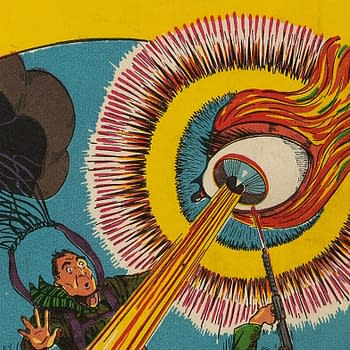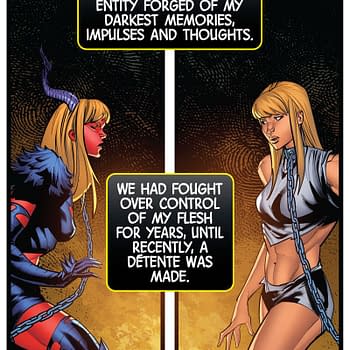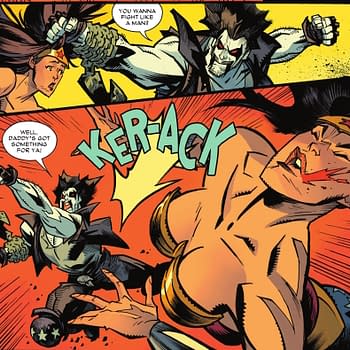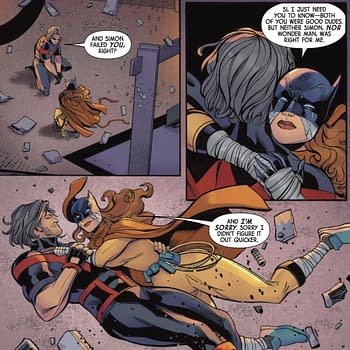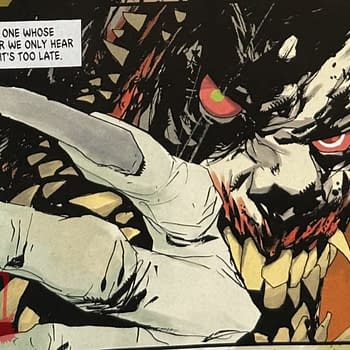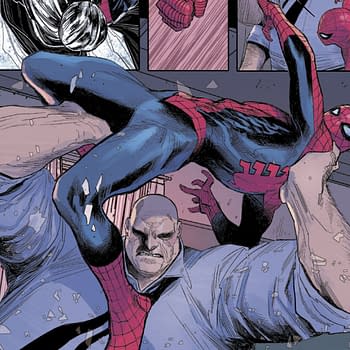Posted in: Comics | Tagged: Comics, hate crimes, howard chaykin, image, image comics, lgbt, LGBTQ, racism, the divided states of hysteria, trans
Howard Chaykin Responds To Controversy
We've been covering the controversy caused by Howard Chaykin's latest comic, The Divided States of Hysteria, extensively here at Bleeding Cool. Not just the incredibly graphic cover to the comic's fourth issue, revealed recently as part of Image Comics' September solicits, and the intense backlash and upset that it caused, but also at the start of Pride Month in June when the first issue contained a graphic, sexualised depiction of trans panic violence and the again backlash and upset this caused many, particularly trans readers and other members of the LGBTQ+ audience, and Image's decision to publish it when it did and wrapped in the Pride Month variant cover, no less.
The latter controversy, the cover depicting a violent hate crime against a person of colour, lynched in a street, having suffered genital mutilation, and with a deeply offensive racial slur emblazoned on the body, led to Image releasing what it claimed was a joint statement between themselves and Howard Chaykin, apologising for the upset caused, however also explaining why it was created and released in the first place, and pulling the cover and replacing it with the cover for the sixth and final issue of The Divided States of Hysteria.
However, the statement noticeably contained no quotes from Howard Chaykin himself, no word of apology from the creator in his own words. Well, now it would seem apparent why, as Chaykin has now gone on record to respond to the backlash and criticism and the decision of Image Comics with Freaksugar. The full response can be found by following the link.
Now, I'm going to be honest here: this response from Chaykin has angered me. The trans violence angered me. The cover angered me. But it almost pales in comparison to the incandescent rage I feel now.
Before, whilst I found the work incredibly distasteful, I held no ill will or malice towards Chaykin. I considered his work (which I looked into) morally dubious at best, and abhorrent at worst, and his lofty stance of artistic intent superseding the feelings of the audience, to be pretentious and ignorant, but I honestly can't say I thought too much about the character of the man.
Now, I honestly feel I can say that I consider Chaykin to be the most repugnant, vile, garbage fire wearing a human meat suit, and I pray I never have to meet such an odious and deplorable creature as him in the flesh ever in my existence. I have met enough people like that. I have been victim to enough people like that. I do not need another.
That said, I've got a general idea that people–a number of enthusiasts and several of my fellow professionals–seem incapable of separating the depiction from the act.
This sort of sophistry has plagued me for years, so I suppose I should be used to it. But clearly, some shit never gets old. I have to assume a percentage of these earnest, yet apparently willfully ignorant critics haven't read the book–certainly not issue four, which cover seems to be setting their lives on fire today.
Immediately upon opening, Chaykin raises himself above the critics, the audience, and indeed his colleagues, and accuses all of using clever but false arguments with the intention of deception. Implying a man who throughout the many times that this has happened to him, he has decided to just. Not. Listen.

It's that "but" that undercuts all that "…all for…" No, you're not really. If that were the case, there'd be no buts. The only artistic expression deemed acceptable by that "but" is an anodyne pandering to an apparently easily patronized audience.
Chaykin's attitude towards the audience that he himself is also trying to entertain and engage with is honestly offensive too. He seems to have little regard for the comics reading audience if he believes them all to be so taken in by false arguments and faux-outrage, that he continually believes all of this to be. Because again, he doesn't listen, and especially, it would seem, will not listen to the very marginalised groups whose prejudices and crimes they face he claims his 'art' is shining a light on.
For the record, the cover depicts the horrific wish dream of some 45% of their fellow Americans. Perhaps if they spent a bit more time paying attention to the fact that the world they were born into is on the brink of serious disaster, they might have less time to get worked up about an image of genuine horror that depicts an aspect of that impeding disaster.
WE KNOW! That's WHY we are so 'worked up'! We are the victims of these violences, and have shared how this hurts us, and yet Chaykin damns us with our own anger at the continued USE of us and our pain for his gain. And Chaykin seems to think that our indignation and anger can only be narrowly focused on the most asinine of depictions of the act and not the act itself, again, insulting an audience he clearly has absolutely no regard for.
To be clear, to those members of the community who can't separate the narrative visual presentation of what I and anyone in their right mind regard as a genuinely horrific act from the act itself, I'd suggest you might want to invest some or all of that affronted energetic rage in the midterm elections in 2018.
Or you can still continue to believe that not having your feelings hurt is in the bill of rights somewhere–despite the fact that I'm still not quite sure what all the fuss is about. For the record, apologies are for the guilty.
And here is the truth of it. Image Comics' press release declaring itself a 'joint statement' is a clear and obvious lie. Howard Chaykin himself admits as much as he bluntly says that he still does not see that he did anything wrong or hurtful and that he has nothing to apologise for.
Moreover, he again stands behind the US Constitution as reason to offend wilfully. While people's feelings may not be protected by the bill of rights, common human decency should be enough to make that obvious. Though, at this juncture, I can't imagine Chaykin has an ounce of human decency within him. This is a man who would walk up to a PTSD-sufferer and make gunfire noises, if he thought there was 'art' in it.
Every Wednesday and Friday, they would come to work, each carrying a small suitcase–and at six PM, after an hour spent in the bathroom, would emerge as women. We all had cocktails, smoked a bit of weed, and they hit the streets, to supplement their income as hookers–this in a time before the euphemism "Sex Worker" existed.
Mondays were often filled with horror stories of their night lives–lives they had to live to simply get by. I wasn't paid enough to do more than live with my mother, and I doubt their day jobs did more than cover rent–so those rambles on 42nd street were a basic necessity.
I've often thought about that quartet, every time–and it's all too fucking frequent a time–I read about a transgender woman murdered by a man who claimed, after the fact, that he had no idea what he was walking into–you know, the "trap" defense.
I wonder if Chaykin has ever asked these 'intimate friends' of his how they feel about only ever being portrayed as victimised brutally? Has he ever stopped to consider that his pretty much monotone depiction of the trans community doesn't help, but inspires further fear and unhappiness? But then, does he even care?
Chrissie Silver, the transgender character in The Divided States of Hysteria, has a back story based on several real people I have known and continue to know. Unlike the others in the narrative, she's guilty of no more than self defense, and is railroaded by a court system that, more often than not, buys into that aforementioned trap defense.
For the record, Chrissie Silver is the moral center of the book–a fact that becomes clearer as the narrative progresses, if those whose heads seem to be exploding with self righteous vindictive rage might actually read the book–but that's not the case.
Actually, most critics, including ourselves here at Bleeding Cool, had theorised that this was the most likely direction for trans character Chrissie Silver, because despite what Chaykin believes, we're not all morons. But it's beside the point. Because he doesn't want us to meet the character at a moral point, or a heroic point, or even just in prison. He wants us to see her at her most victimised and used, and damn the consequences. I do not CARE that she is the real moral centre of the story because the book, so far, has delighted more in the shock value of depicting, graphically, that character as victim alone. It took the character's victimisation and USED it, thus using the victimisation and lives of trans people who have lived this heinous situation; and this is a trope that is so overplayed that no matter the intention to see it so dramatically and graphically used again merely punches down at a community already living with a very real fear every. Goddamn. Day.
I agreed without grudge to Image Comics' decision to pull the cover out of concern for the company, as well as for those colleagues of mine producing work for the company. Image Comics, as well as those talents who didn't opt to join the criticism in decrying the cover, the book and implicitly me, of course–were threatened with boycott by these people.
It should also be noted that a number of those colleagues and fellow professionals wholeheartedly supported this internet criticism. It will be interesting to see if any of this crowd steps out of their anodyne comfort zone and produces something that pisses off enough people to send a little discomfort their way.
I find this doubtful, since this bunch knows all too well how to pander to the comic book audience. Bread, buttered–you get the picture.
Some critics and fans had discussed their intentions to personally boycott Image Comics over The Divided States of Hysteria. But few implored that others take the same action, as they all understand that is the responsibility of the consumer to make such a decision. But Chaykin does not want to credit people with such complex decision making skills.
He then goes onto laying into fellow creators at Image who shared their opinions and distaste of the work, further dismissing those creators own works as anodyne (has he read these creators' work himself, or is he doing exactly what he is accusing everyone and their mothers of doing as well, and not reading the work?). And of course, again, a dig at an audience that he sees as being pandered to when they say you know what, we're tired of this same old shit again and again.
Sorry–I do go on now and then.
You got that right, buddy. Now do us all a favour and shut the hell up.













